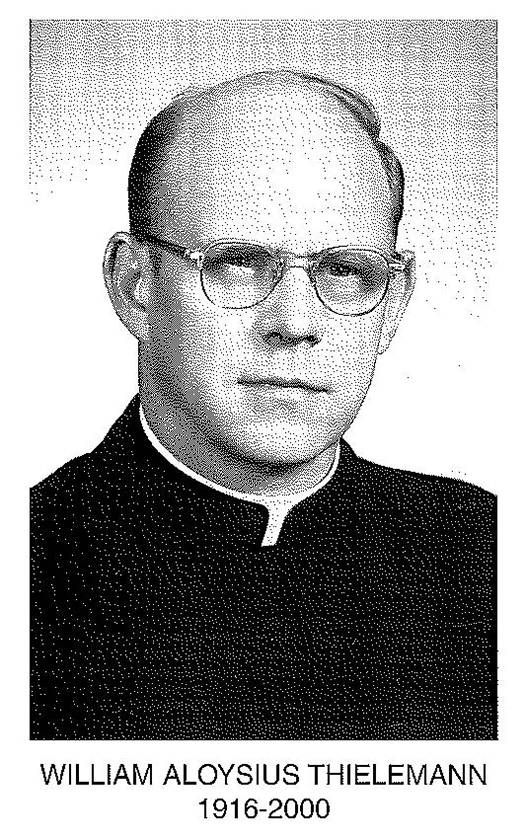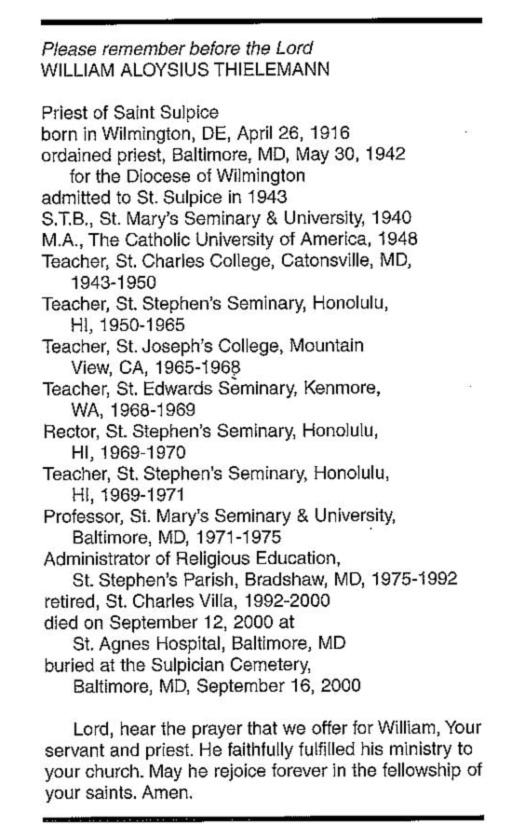Thielemann, Father William A., S.S.
2000, September 12
Date of Birth: 1916, April 25
January 27, 2001
Every human life is a mixture of highs and lows; and the greater the happiness during peak periods the more painful are the descents into times of disappointment. This certainly was verified in the life of Father William Thielemann.
Here is a brief chronology of his life. Born in Wilmington, DE on the twenty-fifth of April 1916 to William Aloysius Thielemann, Sr. and Anna Margaret Eckrich, he received his elementary school education for three years in a Wilmington public school and for five years in St. Patrick’s parochial school in the same city. He entered St. Charles College, Catonsville, MD as a high school sophomore after spending his first high school year at the Salesianum, Wilmington.
Following graduation from St. Charles in 1936 he attended St. Mary’s Seminary on Paca Street in downtown Baltimore for two years of philosophy and St. Mary’s, Roland Park, for four years of theology. As a student at St. Mary’s he applied for admission to the Society of St. Sulpice, and plans began to be discussed about the specifics of his Sulpician ministry. His early inclination was towards the field of theology but his considerable talent for playing the piano and the organ also suggested liturgical music as a proper field for him, so that during these seminary days he traveled to Peabody Institute to take whatever courses he could fit into his seminary schedule. Eventually, because there was need for additional Sulpicians in the several minor seminaries operated by the Society, he was directed toward preparing for work at that level.
Father Thielemann’s diocese was Wilmington but his ordination for that diocese and for the Society took place in Baltimore, in the old Cathedral (now the Basilica of the National Shrine) of the Assumption of the Blessed Virgin Mary on May 30, 1942. He had asked his own bishop for permission to be ordained with his Baltimore classmates since he was the sole ordinand for Wilmington that year. He was ordained with them by Archbishop Michael Curley.
Father Thielemann spent the academic year 1942-1943 in the Sulpician formation program, Solitude. From the fall of 1943 to June of 1950, with a year out in 1946-1947 to earn an M.A. in Latin and Greek at Catholic University, Washington, D.C., he taught Latin, Greek, German, History and Geometry at St. Charles College, his alma mater.
Meanwhile, in the diocese of Honolulu, Territory of Hawaii, in 1947 a new minor seminary, St. Stephen’s, had been established under Sulpician direction, staffed at first by Sulpician Fathers John Linn and Richard Cullinan alone. Father Thielemann was sent to join them in 1950. He would remain a prominent part of St. Stephen’s for a total of seventeen years in two segments (1950-1965 and 1969-1971). Between the two segments he taught at St. Joseph’s College, Mountain View, CA (three years) and St. Edward’s, Kenmore, WA (one year). Like so many minor seminary teachers, Bill taught at one time or another twelve different courses, ranging from religion through Latin and Greek to history and geometry. For one year (1969-1970) within this period he also served as rector of St. Stephen’s.
In 1971 our friend joined the staff of St. Mary’s Seminary and University in Baltimore. There, until 1975, he taught courses in biblical languages and was Administrative Assistant to the Rector, Faculty Secretary, Associate Academic Dean and Registrar.
In September of 1975 Father Thielemann’s life took a new direction when he transferred from seminary work to parochial ministry as Administrator of Religious Education at a suburban Baltimore parish, St. Stephen’s in Bradshaw, MD. This assignment would last until he retired in 1992 and moved into St. Charles Villa, Catonsville, MD, on property adjoining that on which once stood St. Charles College, his alma mater and the scene of his first assignment as a Sulpician. Life had, in a sense, come full circle.
He died on September 12, 2000 in St. Martin’s Home, to which the Villa is adjacent. His funeral Mass was celebrated in the beautiful Chapel of Our Lady of Angels, now the parish church for the Catholic residents of the retirement community called Charlestown, but originally the chapel of St. Charles College. Father Ronald D. Witherup, S.S., Provincial Superior presided at the Mass and the homily was delivered by Father John A. Ward, S.S., who had been a fellow worker with Father Thielemann in Hawaii for nine years. Burial was in the Sulpician cemetery nearby.
Father Thielemann himself would tell you, I believe, that his life between ordination and retirement was composed of many small ups and downs but, speaking more sweepingly, that it consisted of two extended periods of elation, one near the beginning and the other near the end of his productive years, and that in between these two high points there lay a ten-year valley of considerable unhappiness and frustration and even some depression.
The two most gratifying periods of his adult life were the fifteen continuous years of service at St. Stephen’s in Hawaii in his early priesthood and his seventeen years at St. Stephen’s in Bradshaw just before his retirement. He spoke frequently and glowingly of both assignments as times of gratifying accomplishments and of enormous affirmation and resultant joy.
What the two eras had in common was that both were times of very close and loving relationships with people and particularly with young people. In his fifteen consecutive years on the staff of the seminary in Hawaii he was warmly accepted, respected and loved by the St. Stephen’s community, composed of a small, unified faculty that looked up to Bill as one of its pioneers, a correspondingly small student body, mostly Asian-American in its culture (with which he resonated beautifully), and a community of six or eight Marist Missionary Sisters, who attended to most of the domestic needs of the seminary.
His good rapport with the students flowed in great part from the large amount of sharing between him and them, even outside of time in the classroom. Together they did much of the yard work of the seminary. Also, Bill served as an unofficial dean of students and moral officer, leading them on hikes, supervising their cookouts and teaching them useful hobbies.
Over the years he maintained cordial relations with the Sisters, some of whom mentioned at the time of his death how fondly they remembered his many acts of kindness. At one time, for example, with the use of one of the kits that were then popular, he built a complete stereo set for their convent.
He also became very pleasantly involved in the life of a family living on the seminary property, a Japanese-American couple, Robert and Laura Murakami and their five children who grew up there. The parents were employed by the seminary and they and their children became very close to Father Bill and he to them. They were attracted by his gentleness and good humor and he was equally charmed by their wholesomeness and lively sense of fun.
This friendship, begun during his early years in Hawaii, continued to thrive on into the years of his mainland appointments and his eventual retirement. The fact that some members of this family made the trip from Hawaii to Baltimore to visit him in his retirement at St. Charles Villa indicates how firm and lasting was the bond that united them.
At St. Stephen’s, Bradshaw, his life was intertwined with the lives of his young pupils in the religious education program and in the parish school and with their families. He knew these children personally and by name, probably by the hundreds, gained their confidence and affection, witnessed their subsequent growth as well as the mishaps that undoubtedly befell some of them and, in general, he was a loved member of many, many Bradshaw families. The flood of cards that arrived of his birthdays and on other occasions from both adults and children of St. Stephen’s parish bears witness to this.
But not all was rosy all the time.
During the ten years between Bill’s initial period of service in Hawaii and the beginning of his work in the Bradshaw parish, his life was much less productive and gratifying than it had been or would be again. These were the years of various short-lived assignments in Mountain View, CA; Seattle, WA; back again briefly in Hawaii; and finally at St. Mary’s, Baltimore. Although he was dealing with people who, by and large, were friendly and fair-minded, these assignments were also marked by not a few negative aspects.
For one thing, this was the Viet Nam War era, a time of confusion, tension and conflict for many people besides Father Bill. The limits of authority were being widely tested. War was being waged between the generations, with the old widely distrusted by the young. Among Catholics it was a moment of initial adjustment to the output of the Second Vatican Council, an adjustment made by some quickly and enthusiastically and by others more slowly and reluctantly, and in some cases only partially.
At this period of his life Father Thielemann shared the puzzlement and anxiety of many other people over what was happening in the world and particularly in the church and in seminaries. He had led a rather circumscribed life, without much exposure early on to the developments leading up to the Council, so that when the Council was held and then its decisions began to be implemented, he was caught by surprise. His viewpoint and that of some of his superiors and colleagues and of some of the seminarians were likely to clash, and frequently did. Additionally, inadequate or unclear communication seems to have given rise to a host of misunderstandings. There was pain on both sides, and some anger, too.
Consequently, the decade 1965 to 1975 was not a happy time for Father Bill. He weathered these years, though, seemed not to hold grudges and once he had begun his ministry in Bradshaw, he quickly returned to his usual benign self, probably all the better person for having had to face and deal with frustration.
During his eight years of retirement at the Villa, although his ability to remember failed markedly, psychically and spiritually Bill was at peace. But his general physical health was deteriorating, especially his mobility, his breathing and the condition of his heart. He began more and more to feel physical pain. Throughout his life he had been obliged to deal with numerous medical problems. He had undergone serious surgeries more often than most people, including once for a heart valve replacement and another time for a total knee replacement. Hence, for most of his years of retirement Bill was confined to a wheel chair and as the years piled up, he became more and more dependent on others and increasingly lonely and in need of attention. Even so, he continued to have a ready smile and when asked how he felt, his usual answer was, “Oh, I’m fine.”
When death came it probably came as a relief for him. We who knew Father Thielemann well, even as we grieved over his death and prayed for his repose, were confident that he would be quickly delivered into the embrace of the God whom he had lovingly, joyfully and faithfully served during a lifetime marked mostly by those two peaks of happy productivity along with the briefer valley of disappointment and suffering, Such, surely, is the life of so many faithful Christians, lived in solidarity with the earthly pilgrimage of their Savior, whose own life was a composite of the joyful, the sorrowful and the glorious.


